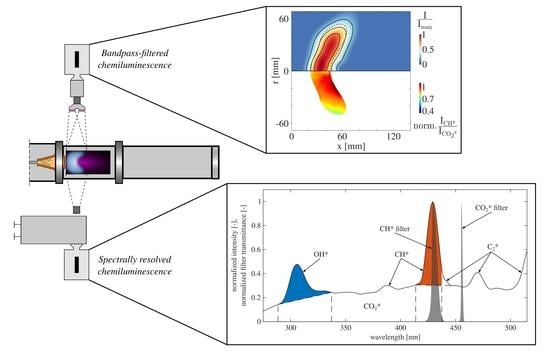Optical Equivalence Ratio Measurement of a Dual Fuel Burner for Natural Gas and Kerosene
Abstract
:1. Introduction
2. Experimental Setup and Measurement Techniques
2.1. Single Burner Test Rig
2.2. Spectrally Resolved Chemiluminescence
2.3. Bandpass-Filtered Chemiluminescence
- CO*-filter with a centre wavelength (CWL) of 456.42 nm, a peak transmission of 68.18% and a full width at half maximum (FWHM) of 2.4 nm
- CH*-filter with a CWL of 431.39 nm, a peak transmission of 48.63% and a FWHM of 10.6 nm
3. Results
3.1. Global Equivalence Ratio from Spectrally Resolved Chemiluminescence
3.2. Bandpass-Filtered Chemiluminescence Results
4. Summary and Conclusions
Author Contributions
Funding
Data Availability Statement
Acknowledgments
Conflicts of Interest
References
- Candel, S.; Durox, D.; Schuller, T.; Bourgouin, J.F.; Moeck, J.P. Dynamics of swirling flames. Annu. Rev. Fluid Mech. 2014, 46, 147–173. [Google Scholar] [CrossRef]
- Lieuwen, T.C.; Yang, V. Combustion Instabilities in Gas Turbine Engines; American Institute of Aeronautics and Astronautics: Reston, VA, USA, 2005. [Google Scholar] [CrossRef]
- Huang, Y.; Yang, V. Dynamics and stability of lean-premixed swirl-stabilized combustion. Prog. Energy Combust. Sci. 2009, 35, 293–364. [Google Scholar] [CrossRef]
- Lieuwen, T.; Torres, H.; Johnson, C.; Zinn, B. A mechanism of combustion instability in lean premixed gas turbine combustors. J. Eng. Gas Turbines Power 2001, 123, 182–189. [Google Scholar] [CrossRef]
- Ducruix, S.; Schuller, T.; Durox, D.; Candel, S. Combustion dynamics and instabilities: Elementary coupling and driving mechanisms. J. Propuls. Power 2003, 19, 722–734. [Google Scholar] [CrossRef]
- Hirsch, C.; Fanaca, D.; Reddy, P.; Polifke, W.; Sattelmayer, T. Influence of the swirler design on the flame transfer function of premixed flames. In Proceedings of the ASME Turbo Expo, Reno, NV, USA, 6–9 June 2005. [Google Scholar]
- Komarek, T.; Polifke, W. Impact of swirl fluctuations on the flame response of a perfectly premixed swirl burner. J. Eng. Gas Turbines Power 2010, 132, 1–7. [Google Scholar] [CrossRef]
- Stöhr, M.; Sadanandan, R.; Meier, W. Phase-resolved characterization of vortex-flame interaction in a turbulent swirl flame. Exp. Fluids 2011, 51, 1153–1167. [Google Scholar] [CrossRef] [Green Version]
- Lieuwen, T.C. Unsteady Combustor Physics; Cambridge University Press: Cambridge, UK, 2012. [Google Scholar] [CrossRef] [Green Version]
- Lieuwen, T.; Zinn, B.T. The role of equivalence ratio oscillations in driving combustion instabilities in low NOx gas turbines. Symp. (Int.) Combust. 1998, 27, 1809–1816. [Google Scholar] [CrossRef]
- Sattelmayer, T. Influence of the combustor aerodynamics on combustion instabilities from equivalence ratio fluctuations. J. Eng. Gas Turbines Power 2003, 125, 11–19. [Google Scholar] [CrossRef]
- Guen Lee, J.; Kim, K.; Santavicca, D.A. Measurement of equivalence ratio fluctuation and its effect on heat release during unstable combustion. Proc. Combust. Inst. 2000, 28, 415–421. [Google Scholar]
- Li, H.; Wehe, S.D.; McManus, K.R. Real-time equivalence ratio measurements in gas turbine combustors with a near-infrared diode laser sensor. Proc. Combust. Inst. 2011, 33, 717–724. [Google Scholar] [CrossRef]
- Bluemner, R.; Paschereit, C.O.; Oberleithner, K. Generation and transport of equivalence ratio fluctuations in an acoustically forced swirl burner. Combust. Flame 2019, 209, 99–116. [Google Scholar] [CrossRef]
- Kather, V.; Lückoff, F.; Paschereit, C.O.; Oberleithner, K. Interaction of equivalence ratio fluctuations and flow fluctuations in acoustically forced swirl flames. Int. J. Spray Combust. Dyn. 2021, 13, 72–95. [Google Scholar] [CrossRef]
- Eckstein, J.; Freitag, E.; Hirsch, C.; Sattelmayer, T.; von der Bank, R.; Schilling, T. Forced low-frequency spray characteristics of a generic airblast swirl diffusion burner. J. Eng. Gas Turbines Power 2005, 127, 301–306. [Google Scholar] [CrossRef]
- Kumara Gurubaran, R.; Sujith, R.I. Dynamics of spray-swirl-acoustics interactions. Int. J. Spray Combust. Dyn. 2011, 3, 1–22. [Google Scholar] [CrossRef] [Green Version]
- Christou, T.; Stelzner, B.; Zarzalis, N. Influence of an oscillating airflow on the prefilming airblast atomization process. At. Sprays 2021, 31, 1–14. [Google Scholar] [CrossRef]
- Docquier, N.; Candel, S. Combustion control and sensors: A review. Prog. Energy Combust. Sci. 2002, 28, 107–150. [Google Scholar] [CrossRef]
- Hardalupas, Y.; Orain, M. Local measurements of the time-dependent heat release rate and equivalence ratio using chemiluminescent emission from a flame. Combust. Flame 2004, 139, 188–207. [Google Scholar] [CrossRef]
- Muruganandam, T.M.; Kim, B.H.; Morrell, M.R.; Nori, V.; Patel, M.; Romig, B.W.; Seitzman, J.M. Optical equivalence ratio sensors for gas turbine combustors. Proc. Combust. Inst. 2005, 30, 1601–1609. [Google Scholar] [CrossRef]
- Panoutsos, C.S.; Hardalupas, Y.; Taylor, A.M. Numerical evaluation of equivalence ratio measurement using OH* and CH* chemiluminescence in premixed and non-premixed methane-air flames. Combust. Flame 2009, 156, 273–291. [Google Scholar] [CrossRef] [Green Version]
- Kathrotia, T.; Riedel, U.; Seipel, A.; Moshammer, K.; Brockhinke, A. Experimental and numerical study of chemiluminescent species in low-pressure flames. Appl. Phys. B Lasers Opt. 2012, 107, 571–584. [Google Scholar] [CrossRef] [Green Version]
- Kojima, J.; Ikeda, Y.; Nakajima, T. Spatially resolved measurement of OH*, CH*, and C2* chemiluminescence in the reaction zone of laminar methane/air premixed flames. Proc. Combust. Inst. 2000, 28, 1757–1764. [Google Scholar] [CrossRef]
- Kojima, J.; Ikeda, Y.; Nakajima, T. Basic aspects of OH(A), CH(A), and C2(d) chemiluminescence in the reaction zone of laminar methane-air premixed flames. Combust. Flame 2005, 140, 34–45. [Google Scholar] [CrossRef]
- Orain, M.; Hardalupas, Y. Measurements of local mixture fraction of reacting mixture in swirl-stabilised natural gas-fuelled burners. Appl. Phys. Lasers Opt. 2011, 105, 435–449. [Google Scholar] [CrossRef]
- García-Armingol, T.; Ballester, J.; Smolarz, A. Chemiluminescence-based sensing of flame stoichiometry: Influence of the measurement method. Meas. J. Int. Meas. Confed. 2013, 46, 3084–3097. [Google Scholar] [CrossRef]
- Najm, H.N.; Paul, P.H.; Mueller, C.J.; Wyckoff, P.S. On the adequacy of certain experimental observables as measurements of flame burning rate. Combust. Flame 1998, 113, 312–332. [Google Scholar] [CrossRef]
- Nori, V.N. Modeling and Analysis of Chemiluminescence Sensing for Syngas, Methane and jet-a Combustion. Ph.D. Thesis, Georgia Institute of Technology, Atlanta, GA, USA, 2008. [Google Scholar]
- Kathrotia, T.; Riedel, U.; Warnatz, J. A numerical study on the relation of OH*, CH*, and C2* chemiluminescence and heat release in premixed methane flames. In Proceedings of the European Combustion Meeting, Vienna, Austria, 14–17 April 2009. [Google Scholar]
- Samaniego, J.M.; Egolfopoulos, F.N.; Bowman, C.T. CO2* chemiluminescence in premixed flames. Combust. Sci. Technol. 1995, 109, 183–203. [Google Scholar] [CrossRef]
- Yi, T.; Santavicca, D.A. Flame spectra of a turbulent liquid-fueled swirl-stabilized lean-direct injection combustor. J. Propuls. Power 2009, 25, 1058–1067. [Google Scholar] [CrossRef]
- Lee, H.; Seo, S. Experimental study on spectral characteristics of kerosene swirl combustion. Procedia Eng. 2015, 99, 304–312. [Google Scholar] [CrossRef] [Green Version]
- Józsa, V.; Kun-Balog, A. Spectroscopic analysis of crude rapeseed oil flame. Fuel Process. Technol. 2015, 139, 61–66. [Google Scholar] [CrossRef] [Green Version]
- Lauer, M. Determination of the Heat Release Distribution in Turbulent Flames by Chemiluminescence Imaging. Ph.D. Thesis, Technical University of Munich, Munich, Germany, 2011. [Google Scholar]
- Vogel, M.; Bachfischer, M.; Kaufmann, J.; Sattelmayer, T. Experimental investigation of equivalence ratio fluctuations in a lean premixed kerosene combustor. Exp. Fluids 2021, 62, 1–14. [Google Scholar] [CrossRef]
- Sangl, J.; Mayer, C.; Sattelmayer, T. Dynamic adaptation of aerodynamic flame stabilization of a premix swirl burner to fuel reactivity using fuel momentum. J. Eng. Gas Turbines Power 2011, 133, 071501. [Google Scholar] [CrossRef]
- Bade, S.; Wagner, M.; Hirsch, C.; Sattelmayer, T.; Schuermans, B. Design for thermo-acoustic stability: Modeling of burner and flame dynamics. J. Eng. Gas Turbines Power 2013, 135, 111502. [Google Scholar] [CrossRef]
- Ashgriz, N. Handbook of Atomization and Sprays: Theory and Applications; Springer: New York, NY, USA, 2011. [Google Scholar]
- Eckstein, J. On the Mechanisms of Combustion Driven Low-Frequency Oscillations in Aero-Engines. Ph.D. Thesis, Technical University of Munich, Munich, Germany, 2004. [Google Scholar]
- Stadlmair, N.V. Influence of Water Injection on the Thermoacoustic Stability of a Lean-Premixed Combustor. Ph.D. Thesis, Technical University of Munich, Munich, Germany, 2018. [Google Scholar]
- Reader, J.; Sansonetti, C.J.; Bridges, J.M. Irradiances of spectral lines in mercury pencil lamps. Appl. Opt. 1996, 35, 78–83. [Google Scholar] [CrossRef] [PubMed]
- John, R.R.; Summerfield, M. Effect of turbulence on radiation intensity from propane-air flames. J. Jet Propuls. 1957, 27, 169–175. [Google Scholar] [CrossRef]
- Dribinski, V.; Ossadtchi, A.; Mandelshtam, V.A.; Reisler, H. Reconstruction of abel-transformable images: The gaussian basis-set expansion abel transform method. Rev. Sci. Instrum. 2002, 73, 2634. [Google Scholar] [CrossRef] [Green Version]
- Hickstein, D.D.; Gibson, S.T.; Yurchak, R.; Das, D.D.; Ryazanov, M. A direct comparison of high-speed methods for the numerical Abel transform. Rev. Sci. Instrum. 2019, 90, 065115. [Google Scholar] [CrossRef] [PubMed]
- Bobusch, B.C.; Cosic, B.; Moeck, J.P.; Paschereit, C.O. Optical measurement of local and global transfer functions for equivalence ratio fluctuations in a turbulent swirl flame. In Proceedings of the ASME Turbo Expo, San Antonio, TX, USA, 3–7 June 2013. [Google Scholar]
- Klarmann, N.E. Modeling Turbulent Combustion and CO Emissions in Partially-Premixed Conditions Considering Flame Stretch and Heat Loss. Ph.D. Thesis, Technical University of Munich, Munich, Germany, 2019. [Google Scholar]
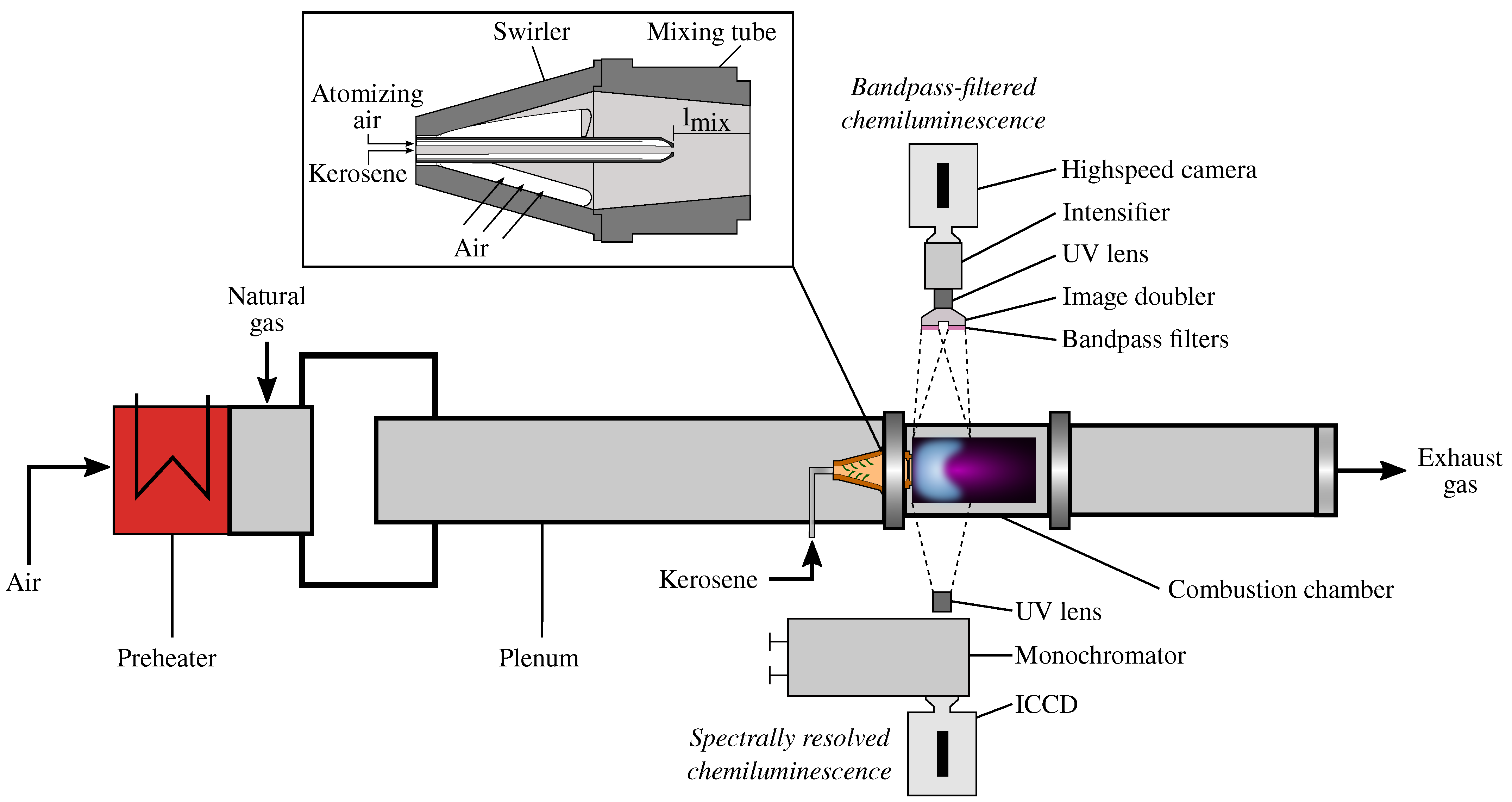
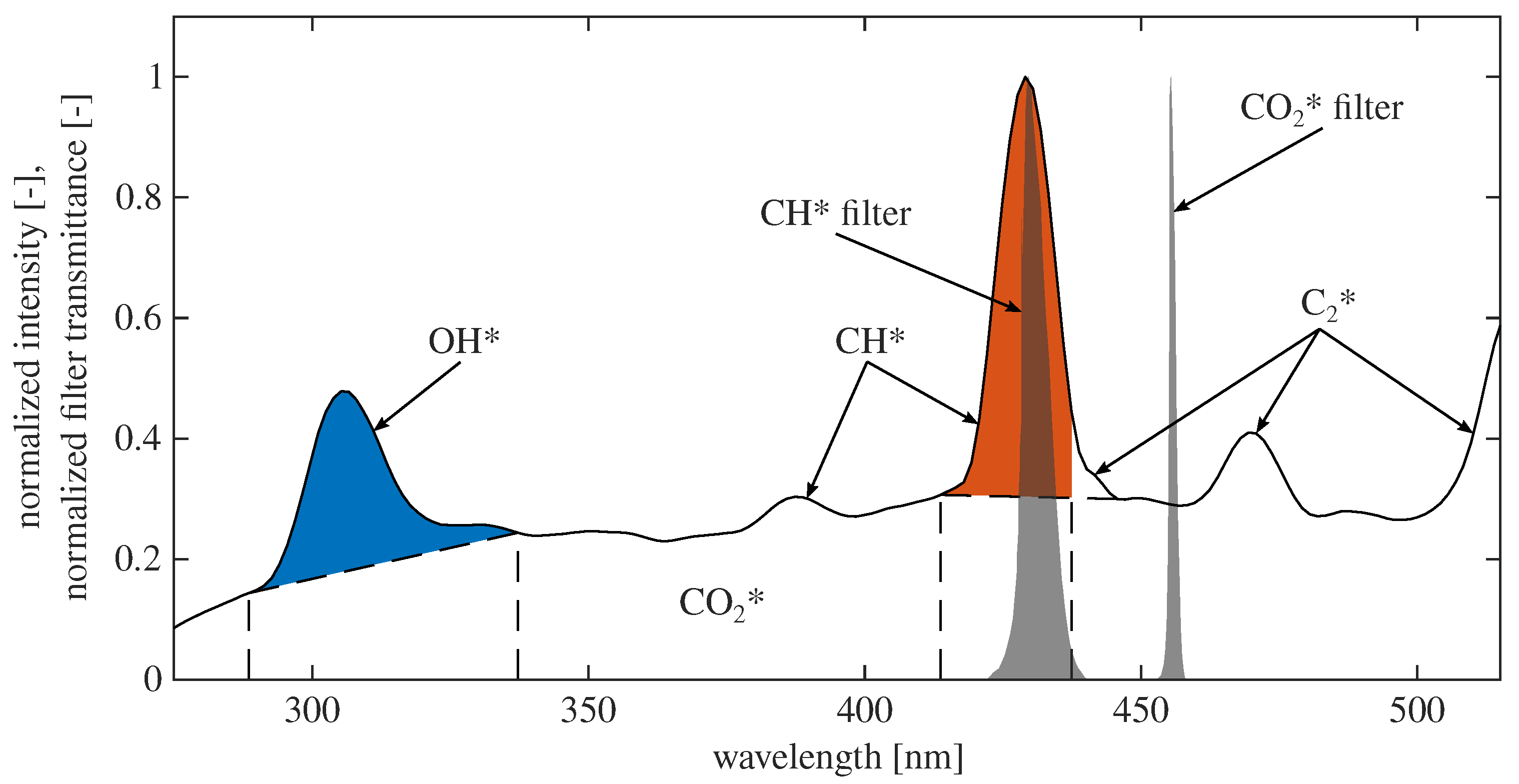
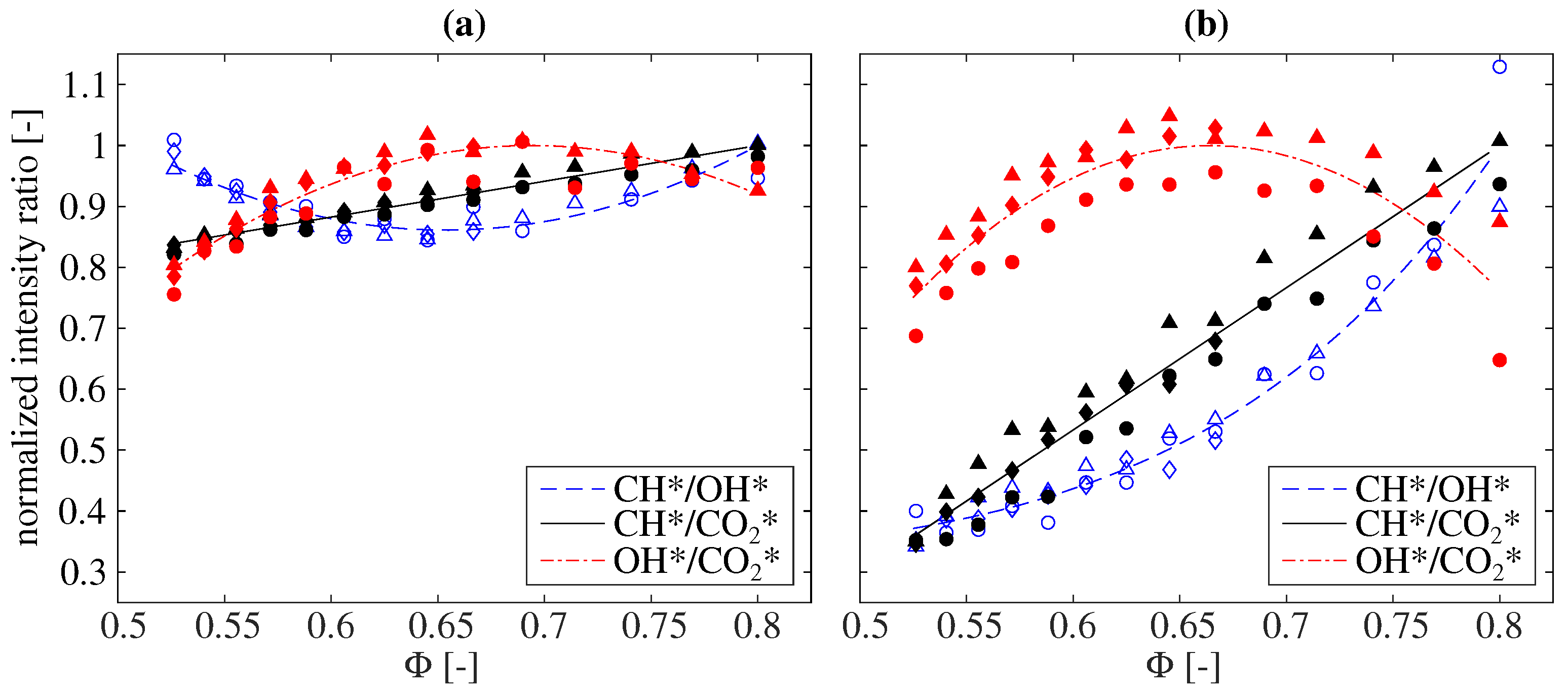
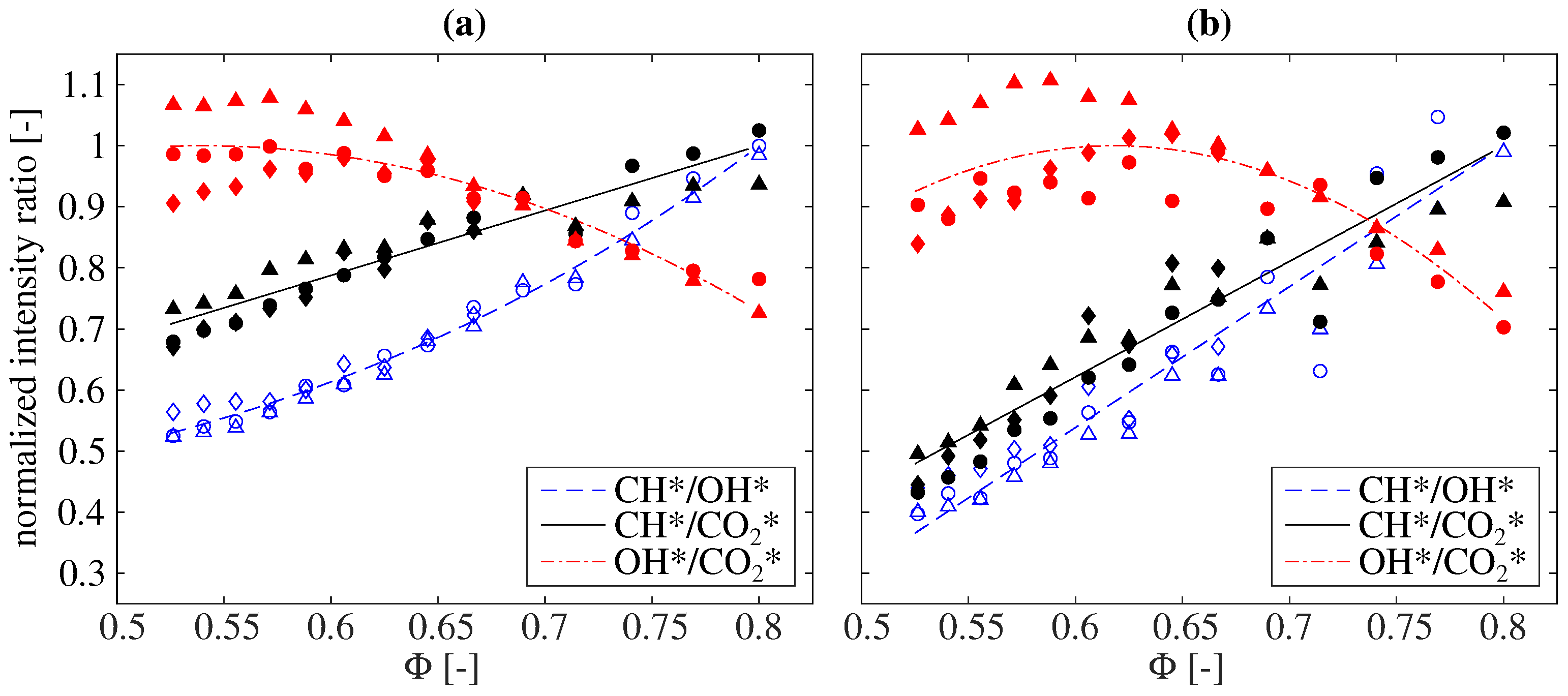
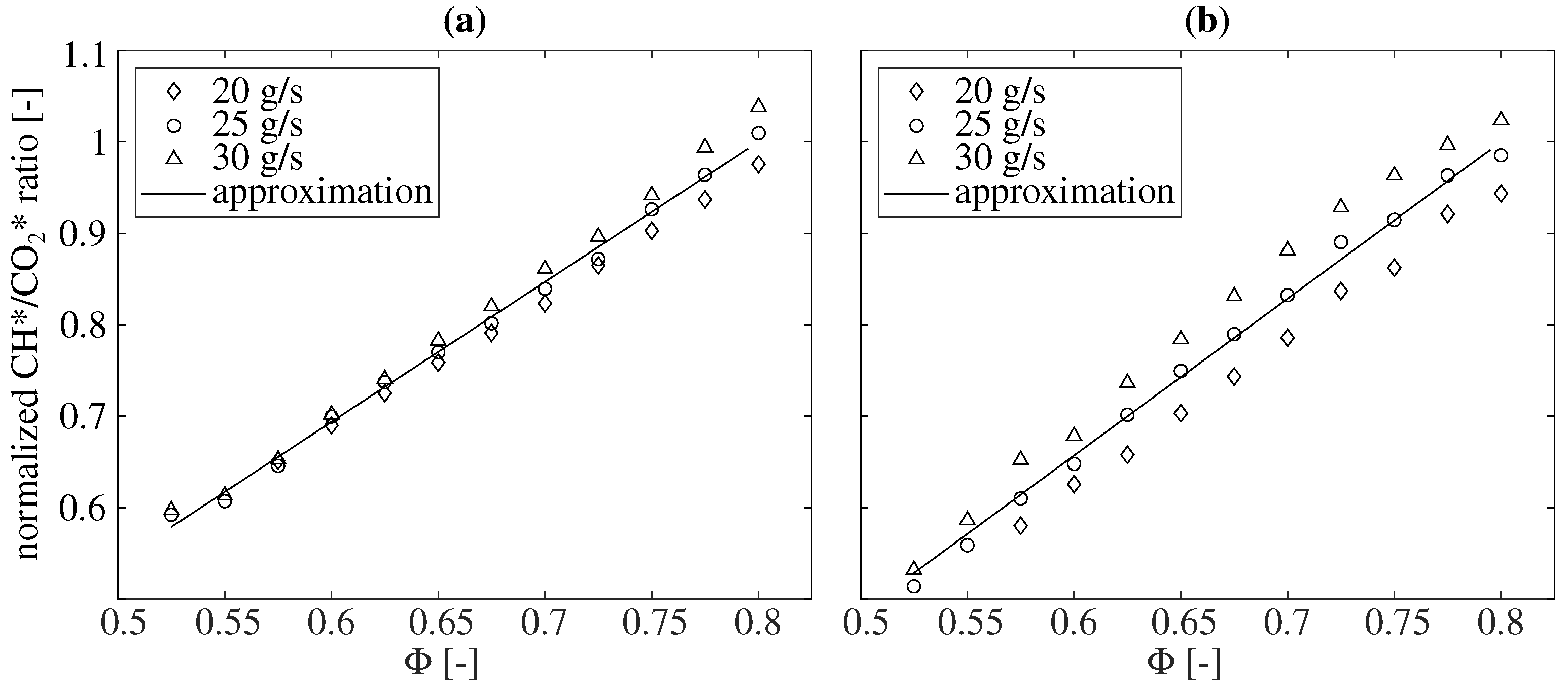


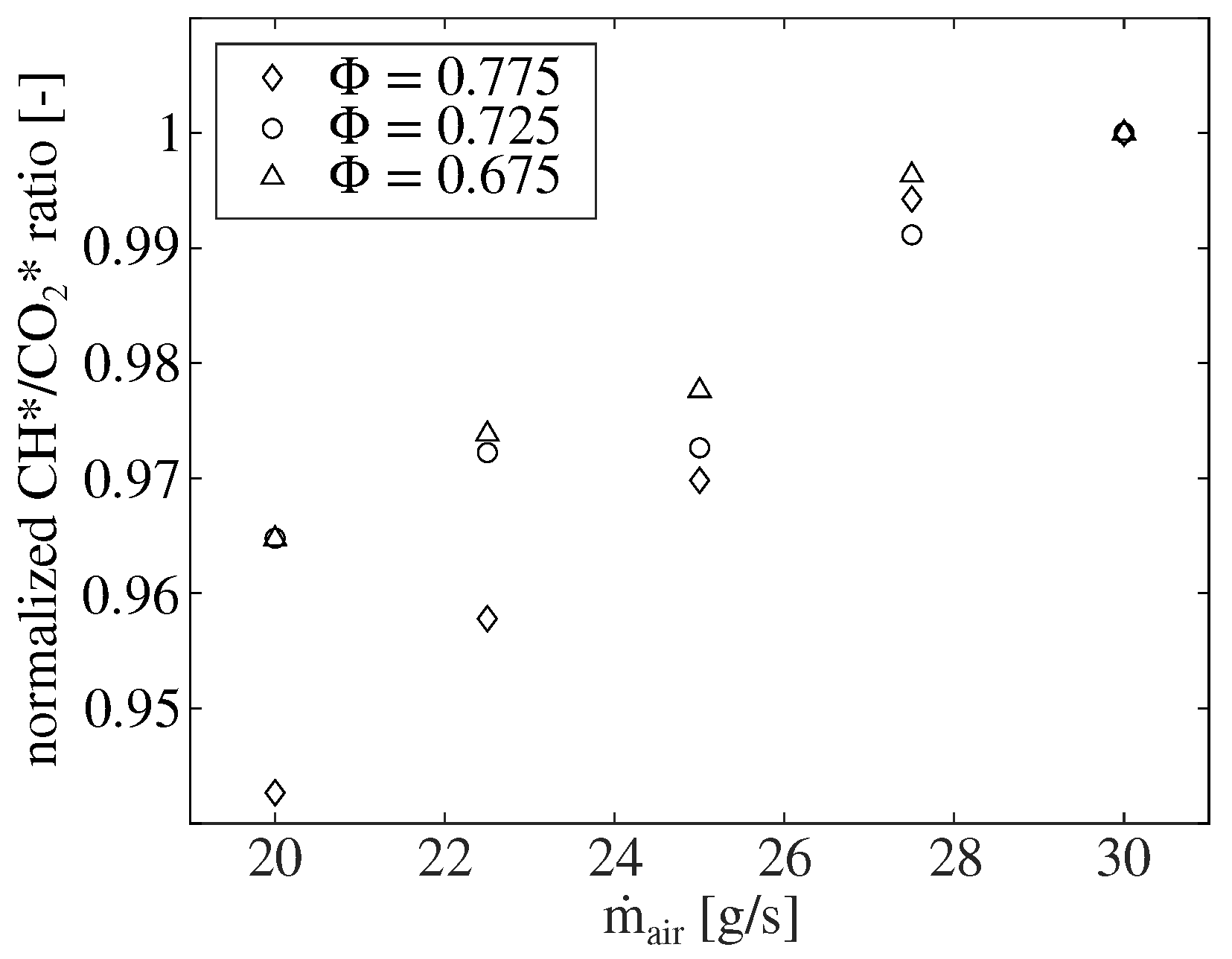


Publisher’s Note: MDPI stays neutral with regard to jurisdictional claims in published maps and institutional affiliations. |
© 2022 by the authors. Licensee MDPI, Basel, Switzerland. This article is an open access article distributed under the terms and conditions of the Creative Commons Attribution (CC BY) license (https://creativecommons.org/licenses/by/4.0/).
Share and Cite
Vogel, M.; Bachfischer, M.; Kaufmann, J.; Sattelmayer, T. Optical Equivalence Ratio Measurement of a Dual Fuel Burner for Natural Gas and Kerosene. Fluids 2022, 7, 43. https://doi.org/10.3390/fluids7020043
Vogel M, Bachfischer M, Kaufmann J, Sattelmayer T. Optical Equivalence Ratio Measurement of a Dual Fuel Burner for Natural Gas and Kerosene. Fluids. 2022; 7(2):43. https://doi.org/10.3390/fluids7020043
Chicago/Turabian StyleVogel, Manuel, Michael Bachfischer, Jan Kaufmann, and Thomas Sattelmayer. 2022. "Optical Equivalence Ratio Measurement of a Dual Fuel Burner for Natural Gas and Kerosene" Fluids 7, no. 2: 43. https://doi.org/10.3390/fluids7020043
APA StyleVogel, M., Bachfischer, M., Kaufmann, J., & Sattelmayer, T. (2022). Optical Equivalence Ratio Measurement of a Dual Fuel Burner for Natural Gas and Kerosene. Fluids, 7(2), 43. https://doi.org/10.3390/fluids7020043







